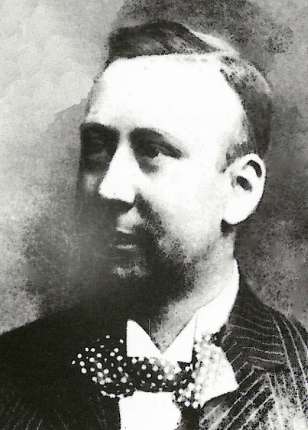George Harry Willoughby
- Birth date 6 December 1858
- Baptism 9 January 1859 at St Thomas Stockport
- Married (I) 29 August 1889 to Agnes Bell Hamilton at Stockport
- Married (II) 20 June 1903 to Jennie Roberts
- Death date 1934? CHECK
The son of John Willoughby and Emma, of Stockport, George Harry Willoughby was born at Stockport, on 6 December 1858 (or 4 December 1859 - Pike) and educated at the Stockport Grammar School, and at the Grammar School, Bedford.
He joined in partnership with S. Taylor Smith, and John Henry Woodhouse under the style Smith Woodhouse and Willoughby. After Smith left, the remaining partners continued in partnership as Woodhouse and Willoughby until 30 June 1905 when the practice was dissolved by mutual consent. The partnership obtained numerous architectural commissions, for the most part secured in" open competition," including Blackburn Municipal Technical Institute, Rochdale Municipal Technical Institute, Widnes Municipal Technical Institute and Library, Heywood Municipal Technical Institute, Winsford Municipal Technical Institute and Gymnasium, Hyde Municipal Technical Institute and Free Library, Bury Municipal Art Galleries and Public Library, Stockport Infirmary (" Jubilee" additions), Barrow in Furness Technical Institute (Corporation), Colne Municipal Technical Institute, Heaton Moor Town Hall and offices, Salford School Board offices, the Scholarship Higher Grade School (Salford School Board), Marlborough Road School, Hightown (Salford School Board), Lyon Street School, Ancoats (Manchester School Board), Holland Street School (Manchester School Board), the new Grammar Schools, Dudley, Worcestershire; St. Peter's Schools, Stockport; the Wesleyan Schools, Edgeley, Stockport, Fire Station London Road etc.
G H Willoughby was a strong advocate of the "competitive" system in architecture; an enthusiasm which was to prove a contributory factor in his bankruptcy in 1913. In describing his activities after the partnership with Woodhouse was dissolved it was noted:
During the last six or seven years, in addition to the work on which he was employed, he had been engaged in fifty-eight architectural competitions, involving an estimated outlay of £939,200 (sic) He was placed first on four occasions, second on fifteen occasions, and third on three occasions. In addition, he prepared, at the request of the committee interested, two designs for the proposed new Royal Exchange in Piccadilly, for which he received no fee or honorarium. The debtor explained that the cost of preparing so many competitive designs was very heavy, that it entailed the engagement of a special staff of draughtsmen, and that the only return for it would be the obtaining of a fair proportion of the works competed for He further explained that he suffered exceptionally bad fortune. While, on the one hand, some of the works for which he obtained file first award were not proceeded with, in others where he had been placed first by the assessor he was deposed to the second place by the committees concerned in favour of a local man. The Judge, sounding a voice of reason, noted that competitions were about the most expensive form of business an architect could indulge in, because, even if he were at the top, it did not follow that he would get the contract, for there were so many influences at work
G W Willoughby, ever hopeful of the next big competition success which would turn his fortunes around, continued in practice but never recovered his architectural career. A further petition for bankruptcy was filed on 24 March 1923.
Buildings and Designs
Partnerships
| Name | Designation | Formed | Dissolved | Location |
|---|---|---|---|---|
| Smith Woodhouse and Willoughby | Architectural practice | 1886 | 1888 | Manchester |
| Woodhouse and Willoughby | Architectural practice | 1888 | 1905 | Manchester |
| Woodhouse Willoughby (and Langham) | Architectural practice | 1901 | 1902 | Manchester |
